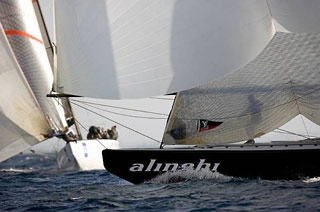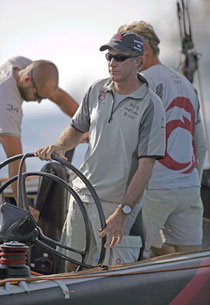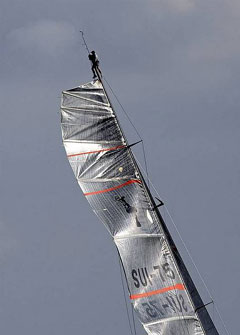|
Road Works:
Alinghi Show December 2005 |
|||||||||||||||||||||||
|
|
|||||||||||||||||||||||
Cover, Cover, Cover. It's an America's Cup mantra and with the 32nd Defender of the America's Cup in sight, we took it to heart. In Chicago, CupInfo was able to chat with Hamish Ross and Ed Baird about a number of topics: Brad Butterworth as skipper? Lifespan of the ACC rule? Parity versus innovation? Read the Chicago Chat On the West Coast, Diane Swintal, fresh off reporting on BMW Oracle's road show, was ready to pounce on Alinghi for us, too. Her report is below. |
|||||||||||||||||||||||
|
The America’s Cup may be alive and well and living in Europe, but the Defender, Switzerland's Alinghi, is making sure the US knows the current state of the Cup, and who the Defender really is. Alinghi helmsman Ed Baird and General Counsel (and America’s Cup historian) Hamish Ross brought the Alinghi story to the Long Beach Yacht Club. They discussed some of the changes to the Cup format and gave an inside look at Alinghi's preparations, with a series of video presentations and some pretty entertaining tales from the sea. Baird introduced Ross by welcoming him to the Long Beach YC, where Baird, as a past winner of the Congressional Cup, is an honorary member. Ross returned the favor, noting the Congressional Cup trophy, displayed prominently in the meeting room, includes names like Bill Ficker, who has contributed so much to the America’s Cup and was in attendance. "It’s almost got to the point that to win the America’s Cup, you’ve got to win the Congressional Cup first," Ross said.
Alinghi is Launched With pleasantries exchanged, Ross described the history of the Cup as the "symbol of yachting supremacy, in terms of sailing skill, design skill, technology - but also management and strategy." Ross acknowledged that Alinghi is the first team not from "an arm of the sea" to win the Cup. However, Lake Geneva has a long history in sailing, even attempting to form a challenge in Fremantle in 1987. Alinghi’s founder, Ernesto Bertarelli, also has a long sailing history, winning Lake Geneva's famous Bol d’Or five times. When Bertarelli began looking at the idea of a challenge for the America’s Cup, a trip to Auckland in 2000 showed that unless he had the right people, there really wasn’t much point in making the attempt. Luckily for Bertarelli, key members of defender Team New Zealand were looking at other options. They approached Bertarelli, and Alinghi was born. Alinghi first raced as a team in 2001 at the America’s Cup Jubilee, in Cowes, England, onboard the 12-meter South Australia. With some changes to the boat, which hadn’t been terribly fast her first time around, the team’s success was so substantial that their last day of the regatta was spent on the golf course, not the race course. That success continued through the 2003 America’s Cup, with Alinghi taking the Cup home to Europe for the first time since 1851. So Now What? The Modern Cup At the moment Alinghi crossed the finish line in race five to win the 2003 America’s Cup, the pre-arranged protocol was signed with Challenger of Record BMW Oracle Racing. The pocket challenge is intended to avoid the problems of 1987, when a rogue challenge was issued before the formal challenge could be arranged. Alinghi and BMW Oracle had planned ahead - as Ross noted, so you don’t "lose control of your event." The teams had also agreed on certain changes. First up on the list of changes was the series of "Pre-Regattas", or Acts. Second was the reintroduction of fleet racing, which had been out of the Cup since 1870. Ross believes there’s nothing more exciting than seeing 12 America’s Cup class yachts lining up, over 300 tons of yachting hardware vying for the start line. "There is one thing slightly more exciting than seeing that," Baird countered, "and that’s driving one of the 12 boats trying to find that little place in the starting line – which is quite frightening." Fleet racing will also make its way into the Cup itself. Seven days of fleet racing will kick off the 2007 Louis Vuitton Cup, races that will include Alinghi. The Acts have had good response from the teams, and especially from Alinghi. Without a Defender selection series during the Cup, they now they have the same opportunity to sharpen their racing skills as the challengers. Without the element of secrecy during these regattas, teams have had the chance to mingle much more. And everyone seems to be taking advantage of the opportunity to check each other out. "In fact," said Ross, "when Team New Zealand had a problem with their spinnaker and had to cut it loose, the chase boat was not right there to grab it. Their chase boat was behind Alinghi, taking a close look at our team and how we were operating!" Ross also addressed the one change that has perhaps caused the most controversy – the removal of the nationality rule. Ross agrees with those who believe there were too many loopholes in the rule, allowing sailors to simply hold residences in the country of the team to make them nationals, which cost the teams millions of dollars. "Globalization has overtaken us, in all walks of life – not only in yacht design, but in materials and equipment," said Ross. He believes that if the strictest of nationality rules were enforced, similar to Olympic rules, where the team and the structures had to come from one country, there would be only defender in the America’s Cup – the United States. An explicit nationality rule for participants has not run the length of the regatta's history. It was introduced by the New York Yacht Club in 1980. In fact, when America won that first Cup in 1851, she had six Brits on board, including a pilot. When the Cup was defended in the late 1800s, the US relied on so many Scandinavian sailors that a translator was required on board. Ross makes an interesting comparison. Take a look at the roster of the World Series Champion Chicago White Sox – how many Chicago natives are on the roster? The last major change is that rather than holding the America's Cup on Switzerland's Lake Geneva, the city of Valencia, Spain, bid to host the race. Valencia was chosen primarily because of the wind - breeze comes in every day at 2 p.m., like clockwork. As in Auckland, the Valencia harbor is undergoing major changes, with Valencia contributing €100 million, and the country of Spain kicking in €1 billion. "Valencia turned its back on the sea for a long period of time," said Ross, "and it’s now turning itself around and embracing the sea." Ed Baird and Alinghi
Ed Baird grew up in St. Petersburg, Florida, and has always embraced the sea. He remembers well the first time the America’s Cup hit his consciousness. "I was in 4th or 5th grade, and for no apparent reason other than it was an international event, our teacher got an old black-and-white television so we could watch the America’s Cup race. It happened to be the day the boats luffed up at the windward end, and the gun went off, and there was an issue of whether they hit, and it was the first time video evidence was used in a protest hearing. It was so cool to see Walter Cronkite out there telling us the story! To be in the middle of it now is terrific." Baird took notice of Alinghi during the early stages of the Louis Vuitton Cup in 2002, while he was working as color commentator for TV New Zealand. Alinghi was discounted as a first-time challenger, from Switzerland of all places, with all the expatriates from New Zealand, but Baird saw the different attitude within the team. "They worked hard, they played hard, and they always looked like they were having a good time, and I think that’s important for success." That attitude, Baird believes, helped as the Louis Vuitton Cup wore on, while other teams pushed too hard and stretched their resources too thin. Alinghi left an impression. Baird came back to the States, got involved in the Swedish Match Tour, got back into the match racing scene, hit the top of the world rankings – but, well, there was one more thing left to do on his sailing resume. So when the phone call came from Brad Butterworth, looking for "another guy to drive the boats," Baird was ready. The opportunity to get involved with the team that he had watched grow was too much to resist.
Baird’s enthusiasm for sailing, and for Alinghi, is obvious. The team is learning "something cool every day" and Baird appreciates being surrounded by people so intensely focused on the team's success. He loves being a part of it. "They come to work every day and they have fun!" "It’s a fascinating mix," Baird continues. "Every day, we’re changing within the team – who drives the boat, who trims the sails, doing the tactics, doing the strategy, doing the bow, all those things are moving around bit by bit to find the perfect mix in the end." The team is testing now in Valencia. They’ll work together until Christmas, then be back in full force in March, and work pretty much full time after next year’s Acts, leading toward the America’s Cup in 2007. Ross’s favorite example of Alinghi’s prowess as a team occurred during the recent Act Nine in Trapani, during a race against United Internet Team Germany, with Baird at the wheel.
Alinghi had a good start, headed upwind just to leeward of Germany. Suddenly, the headcar holding the main to the top of the mast snapped, and the mainsail sank along the luff until it all bunched up over the boom. With the designers shaking their heads, sure the day was done, the front of the boat had Pieter Van Nieuwenhuyzen in a harness and heading up the mast. Van Nieuwenhuyzen put a new halyard on the main, and took the line he’d stuffed in his pocket, secured it to the headcar, and yelled down to the team to trim on. Within three minutes of the breakage, the sail was back up and trimmed, before Van Nieuwenhuyzen had even started back down. Alinghi, now eight boat lengths behind, chipped away at Germany’s lead upwind, passed them on the run, and won the race. While the sailors taking their team work to new heights on the water, back on shore the designers are hard at work on the first of two new boats. The first should be started before Christmas, and launched for the last Acts in May. The design of the second boat, Ross notes, will depend on what the team learns from the first boat. Alinghi’s decisions are perhaps a bit easier than the challengers. As usual, the rules allow a certain amount of good fortune on the part of the defender. Alinghi will have the opportunity to compete in the fleet racing prior to the start of the Louis Vuitton Cup in 2007, but then has several months to make changes and tweak both boats before a decision on which is the race boat must be made. It’s good to be the Defender. The fleet-wide arrival of the new generation ACC yachts next year will considerably reshuffle the deck among the teams, believes Ross. “This is a technology competition as much as a sailing competition. However, the best-funded teams don’t necessarily win the Cup. The more money that’s available, the better chance that they’ll chase every design detail, and frequently, there’s a lack of coordination or focus.” So as the teams leave the 2005 Louis Vuitton Acts in their wake – who gained the most? Who benefited from the pre-regattas, and the chance to see what everyone else has got? Baird believes the teams with the fewest points made the largest gains. “It was a very exciting summer, to get out with all 12 teams, to have this great competition between all of us, to see how you were going to do. They learned a lot, we learned a lot. I believe the newest, the weakest teams going into the pre regattas got the most out of it. They were forced to be there with their sailing team intact, their sails and equipment intact, and their shore crew ready to go. They got better faster than anyone at the top of the pile.” --by Diane Swintal. ©2005 CupInfo
Alinghi.com Official Team Site
|
|||||||||||||||||||||||



